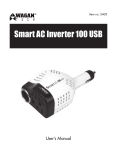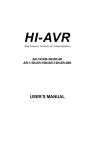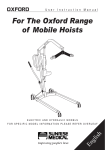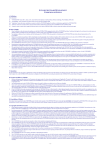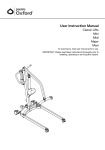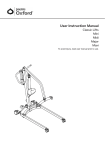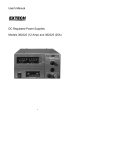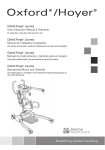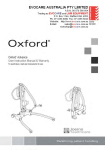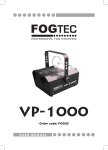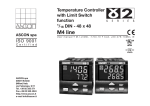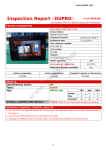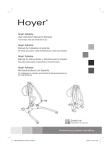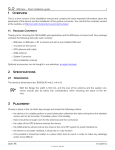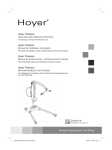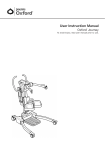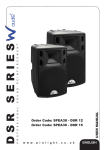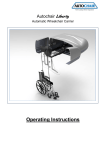Download Oxford Mobile Hoists User Manual
Transcript
Oxford ® Oxford Mobile Hoists User Instruction Manual & Warranty ® To avoid injury, read user manual prior to use. Redefining patient handling Oxford Mobile Hoists ® Manufacturer’s Contact Details Oxford ® EuropE Joerns Healthcare Ltd High Street, Wollaston, Stourbridge, West Midlands DY8 4PS ENGLAND +44 (0)1384 44 66 22 Fax: +44 (0)1384 44 66 01 www.joerns.co.uk Contents 1. Oxford Electric and Hydraulic Lifts......................................................................................... 3 2. Introduction: About Your Lift................................................................................................... 6 3. Assembly and Commissioning Instructions............................................................................ 7 4. Safety Precautions................................................................................................................. 9 5. Oxford Mobile Hoist Controls............................................................................................... 10 6. Stowaway: Assembly and Commissioning Instructions.........................................................11 7. Operating instructions.......................................................................................................... 14 8. Charging instructions............................................................................................................ 17 9. Maintenance schedule & Daily check list............................................................................. 18 10. Technical Specifications....................................................................................................... 20 11. Servicing, Repairs, Inspections & Testing............................................................................ 23 374-10070 Rev A Oxford Mobile Hoists ® Oxford Electric and Hydraulic Lifts STOWAWAY: MINI 140: 374-10070 Rev A Oxford Mobile Hoists ® Midi 170 Major 190 374-10070 Rev A Oxford Mobile Hoists ® Maxi 170 374-10070 Rev A Oxford Mobile Hoists ® 2. Introduction: About Your Lift The Oxford Mobile Hoists are available in two versions, hydraulically operated and electrically operated. This manual covers both versions. (This is with the exception of the Maxi 170 which is electric only). Each lift is fully assembled, load tested and certified before being partially dismantled for packing. The packing consists of a strong, purpose built carton and is used for both export and domestic markets to ensure the safe arrival of the lift. A number of documents are supplied in a wallet packed with each lift and should be kept safely for future reference. • • • • Test Certificate User Manual Dealer Guarantee Card Customer Satisfaction Card The TEST CERTIFICATE is an important document and will be required for your insurance records. It is valid for six months and after it has expired the lift should be inspected and serviced for the following six months. Servicing and periodic testing can be carried out by your supplier. Please ensure your lift is included in their maintenance schedule. Oxford Mobile Hoists are suitable for the following CATEGORIES of lift within the working parameters of the lifts specified in the TECHNICAL SPECIFICATIONS. • • • • • • Category A - Wheelchair Category B - Bed Category C - Bath Category D - Toilet/Shower Chair Category E - Floor Category F - 90 degree Rotation The Oxford Mobile Hoists are suitable for patients in the SITTING, SITTING/RECUMBENT and RECUMBENT positions. The CE mark: 374-10070 Rev A Oxford Mobile Hoists carries the CE mark and complies with the following EC directives: • Medical Device Directive (93/42/EEC) • EMC Directive (89/336/EEC) (Electrics only) • Low Voltage Directive (73/23/EEC) (Electrics only) Oxford Mobile Hoists ® 3. Assembly and Commissioning Instructions Place the carton in a clear working area and open carefully. The carton contains: • • • • • • • Main Wheeled Chassis Mast and Boom Assembly Leg Adjusting Handle Wallet Containing Documents Handcontol (electric only) Battery Charger (electric only) Battery Pack 1. Remove all the parts from the carton and place on the floor, taking care to protect the finish from damage. SAFETY NOTE: Some of the parts are heavy and will need to be lifted with care. You may need assistance with the heavier assemblies. 2. Apply the brakes on the rear castors of the chassis. 3. Fit the mast assembly to the chassis. The mast is located into the rectangular socket on the top centre of the chassis. SAFETY NOTE: Avoid trapping fingers. Keep fingers away from the end of the mast when inserting into the socket. 4. When the mast is fully engaged with the socket, turn the mast locking knob clockwise until fully tightened. SAFETY NOTE: Full engagement of the mast is indicated by the label on the side of the mast. 5. Remove the screw from the leg adjusting lever located at the rear of the chassis. Fit the leg adjusting handle through the gate on the mast and push the open end over the leg adjusting lever. Align the notch in the handle with the cross pin in the lever. The handle is retained by a screw through the clearance hole in the handle into a threaded hole in the lever. Insert screw and fully tighten. NOTE: For Stowaway please refer to page 11 for assembly instructions. 6. Check the legs of the lift open and close satisfactorily. 374-10070 Rev A Oxford Mobile Hoists ® Electric Model: 7. Check the red emergency stop button, located on the Controller is in the out (off position). 8. Fit the handcontrol to the handcontrol socket located at the base of the Controller. WARNING The handcontrol plug is indexed and can only be fitted one way. Do not force, but make sure the plug of the handcontrol is firmly pushed into the socket. 9. Plug the actuator jack plug into the (left socket) actuator socket located at the base of the Controller. 10.Push the up and down buttons on the handcontrol and confirm the boom rises and lowers. The lift is now ready for use. Hydraulic Model: 7. Close the hydraulic unit release valve by turning the knurled black knob on the unit fully clockwise. NOTE: The release valve requires only minimal tightening to operate and should only be closed finger tight. DO NOT apply excessive force to the valve knob as this will result in damage to the valve. 8. Pump the handle of the hydraulic unit and confirm the ram raises the boom. 9. Open the release valve fully anticlockwise and check the boom descends. An unloaded boom will not come down under its own weight, it will be necessary to apply some pressure to the boom before it will descend. WARNING The release valve is fully open and encounters a positive end stop in less than two full turns of the knob. DO NOT force the valve past the end stop as this will result in damage to the valve. 10. Close the release valve. The lift is now ready for use. 374-10070 Rev A Oxford Mobile Hoists ® 4. Safety Precautions Please read and follow the safety precautions listed below. The operation and use of Oxford patient lifts is simple and straightforward. Following these few basic safety precautions will make lifting operations easy and trouble free. WARNING • ALWAYS plan your lifting operations before commencing. • ALWAYS carry out the DAILY CHECK LIST before using the lift. • ALWAYS familiarise yourself with the operating control and safety features of a lift before lifting a patient. •DO NOT use a sling unless it is recommended for use with the lift. • ALWAYS check the sling is suitable for the particular patient and is of the correct size and capacity. • NEVER use a sling which is frayed or damaged. • ALWAYS fit the sling according to the instructions provided (user instructions). • ALWAYS check the safe working load of the lift is suitable for the weight of the patient. • ALWAYS carry out lifting according to the instructions in the user manual. • NEVER disconnect or bypass a control or safety feature because it seems easier to operate the lift. • NEVER force an operating or safety control. All controls are easy to use and do not require excessive force to operate. If a control is not working easily there will be a reason. Forcing will only strain or damage the lift and may compromise safety. •DO NOT lift a patient with the castor brakes on. •DO NOT attempt to manoeuvre the lift by pushing on the mast, boom or patient. • ALWAYS manoeuvre the lift with the handle provided. • ALWAYS lower the patient to the lowest comfortable position before transfers. •DO NOT push a loaded lift at speeds which exceed a slow walking pace (3 Kilometres/hour 0.8 metres/second). •DO NOT push the lift over uneven or rough ground. particularly if loaded. •DO NOT attempt to push or pull a loaded lift over a floor obstruction which the castors are unable to ride over easily. •DO NOT bump the lift down steps, loaded or unloaded. •DO NOT attempt to negotiate a loaded lift on a slope which exceeds 1:12 (approximately 5 degrees). Joerns Healthcare recommend a second helper is present when moving a patient on a slope. •DO NOT park a loaded lift on ANY sloping surface. •DO NOT use electric lifts in a shower. •DO NOT charge an electric lift in a bathroom or shower room. •DO NOT lift a patient unless you are trained and competent to do so. • YOUR lift is for patient lifting. DO NOT use it, or allow it to be used, for any other purpose. 374-10070 Rev A Oxford Mobile Hoists ® 5. Oxford Mobile Hoist Controls Detachable Battery Pack Emergency Stop Button Emergency Raise/Lower Actuator Motor Hand Control Battery Indicator 10 374-10070 Rev A Oxford Mobile Hoists ® 6. Stowaway: Assembly & Commissioning Instructions 1. Remove all the parts from the carton and place on the floor, taking care to protect the finish from damage. WARNING The Stowaway is heavy and will need to be lifted with care. You may need assistance to lift the Stowaway from the carton. 2. Place the folded Stowaway flat on the floor, resting on the rear castors and the folded boom. Engage the brakes on the rear castors. 3. Stand facing the front castors and swing the leg retaining latches clear of the square handle on the mast. Move the legs sideways and downwards to place the front castors on the floor. 11 374-10070 Rev A Oxford Mobile Hoists ® 4. Swing the mast and boom upright and allow the mast to drop into the mast box. WARNING Avoid trapping fingers. Keep fingers away from the end of the mast when inserting into the socket. Engage the mast lock. 5. Remove the quick release pin at the top of the actuator, this will release both the boom and the actuator. Hydraulic version - The hydraulic unit is completely detached when the Stowaway is folded. Remove the quick release pin to release the boom and use the pin to reconnect the top of the hydraulic unit to the boom. Connect the lower mounting of the hydraulic unit to the mast with the second quick release pin stored through the mast bracket. 6. Lift the boom and spreader bar and swing the actuator over to engage with the mounting bracket on the underside of the boom. Secure the actuator to the boom mounting bracket with the quick release pin. WARNING Make sure the quick release pin is correctly located and locked. 12 374-10070 Rev A Oxford Mobile Hoists ® Hand control Retaining Clips Emergency Raise/Lower Leg Adjusting Handle Leg Adjusting Handle Emergency Stop 7. Remove leg adjusting handle from the storage clips on the mast and fit to the leg adjusting lever through the gate on the mast. Fit the battery pack to the mounting point on the mast and connect the power/charging plug to the battery pack. WARNING The handcontrol plug is indexed and can only be fitted one way. Do not force, but make sure the plug of the handcontrol is firmly pushed into the socket. Plug the actuator jack plug into the (left socket) actuator socket located at the base of the Controller. Check the following: • The legs of the lift open and close satisfactorily. • The red emergency stop button, located on the top of the power pack, is in the OFF (out) position. • Push the up and down buttons on the handcontrol and confirm the boom rises and lowers. 13 374-10070 Rev A Oxford Mobile Hoists ® 7. Operating Instructions 1. Leg adjustment: The legs on the Mobile Hoists are adjustable for width. The legs can be opened to enable access around armchairs or wheelchairs. For transferring and negotiating narrow doorways and passages the lift legs should be in the closed position. To achieve the adjustment, the leg adjuster handle, located at the rear of the mast, is moved in towards the mast and then sideways from RIGHT (fully closed) to LEFT (fully open). The adjustment can be carried out with the patient in the lift, but loaded or unloaded the adjustment should be made when the lift is moving. 2. Castors and Braking: The lift has two braked castors which can be applied for parking. When lifting, the castors should be left free and unbraked. The lift will then be able to move to the centre of gravity of the lift. If the brakes are applied it is the patient that will swing to the centre of gravity and this may prove disconcerting and uncomfortable. 3. Straight line steering (where supplied): One of the rear castors is fitted with a straight line steering device. To engage the device simply swing the ‘U’ shaped bar over the end of the leg. There is no need to fit the bar over the castor as it will automatically engage as you move off. 4. Raising and lowering the boom (electric models): The movement of the boom is achieved by a powerful electric actuator which is controlled by a simple handcontrol unit. The handcontrol has two buttons with directional arrows UP and DOWN. The actuator stops automatically at the limit of travel in both directions. The handcontrol plugs into a socket at the base of the Controller. There is a magnetic backing to the handcontrol which allows it to be “parked” on the mast or boom when not in use. 5. Emergency Stop (Electric only): The red Emergency Stop Button is located on the Controller and is activated by pressing in. This will cut all power to the lift and can only be reset by twisting the button anticlockwise and releasing. 6. Emergency Raise/Lower Function: All Oxford Mobile Hoists are fitted with raise/lower buttons on the Controller. These are located underneath the emergency stop button and can be operated by means of inserting a ball point pen tip. This can be used to lower/raise the patient should the hand control fail. Caution should be exercised when using this control as there is no automatic cut-out of the actuator when the top or bottom stop is reached. 7. Emergency Mechanical Lower: Some hoists have the additional feature of a mechanical emergency lower fitted to the actuator. This is identified by a red moulded block at the base of the actuator ram. By pulling on the device upwards the boom will be lowered in a controlled manner. This feature is only to be used when the there is no electrical power to the actuator and the patient needs to be lowered immediately. Before using this feature the electrical lower function should be used check that the emergency stop has not been pressed in and that the battery has adequate charge This feature requires a sufficient downward load to be applied to the boom to work. There may be circumstances where the carer or operator of the hoist will require applying an additional downward force on the boom to enable the boom to be lowered. WARNING Care must be taken to avoid personal injury when applying any additional downward force to the boom in order to activate the emergency descent. 14 374-10070 Rev A Oxford Mobile Hoists ® WARNING Frequent, repetitive use of the emergency descent feature may result in future safety issues with the emergency descent function. If the emergency descent device is used then you are required to contact your service provider to check the hoist to establish what needs replacing or repairing. WARNING Continued use of the hoist after using the emergency descent feature may compromise the duty of care and safety of the patient. 8. Batteries: The batteries are protected from deep discharge by a LOW VOLTAGE ALARM. This will sound when the batteries need recharging and the handcontrol is being operated. It will not sound independently of the handcontrol being operated. DO NOT IGNORE THIS WARNING ALARM. Complete the lifting operation and place the lift on charge (see charging instructions). 9. Raising and lowering the boom (hydraulic models): The raising and lowering of the boom is achieved by a powerful hydraulic ram which is operated by two simple controls. The release valve, which is identified by a black knurled knob, and the pump handle which is a long lever on the side of the hydraulic unit. To raise the boom, ensure the release valve is closed. The valve is closed by gently turning the knurled knob fully clockwise. When closed, pump the long handle with smooth even strokes for maximum effect. The handle strokes from an upright position through an arc of 90 degrees. Leave the handle in the upright position when not in use. WARNING DO NOT force the handle beyond the upper or lower stops. The hydraulic unit can be rotated to allow the handle to be used from either side of the lift. To lower the boom, turn the release valve anticlockwise. The release valve is progressive, the more it is opened the faster the descent. The valve is restricted so even when fully open the descent is controlled. This facility allows for a “hands free” descent. If the release valve is opened a fraction (a quarter turn) a very slow speed of descent will allow the carer to work “hands free” while assisting or comforting the patient. REMEMBER to close the release valve before commencing lifting operations. The release valve only requires gentle pressure to open or close. WARNING DO NOT apply excessive force to the release valve, either to close or to open. It is not necessary and will only damage the valve. 15 374-10070 Rev A Oxford Mobile Hoists ® 10.Slings: The selected sling is attached to the spreader bar hooks. Each sling is supplied with instructions which should be followed carefully. The Oxford mobile hoist range is suitable for patients in the SITTING, SITTING/RECUMBENT and RECUMBENT positions. The slings suitable for this device are listed as follows: • Oxford Quickfit sling • Oxford Quickfit Deluxe sling • Oxford Access sling • Oxford Full Back sling • Oxford Long seat sling • Oxford Silkfit sling When selecting a sling from the Oxford range be sure to assess the suitability of the type of sling for the patient to be lifted. The following guides will assist in the correct selection. NOTE: For detailed fitting instructions, please refer to the user guide supplied with each sling. WARNING Joerns Healthcare recommends that slings be checked regularly and particularly before use for signs of fraying or damage. DO NOT use slings that are worn or damaged. WARNING OXFORD RECOMMENDS THE USE OF GENUINE OXFORD PARTS. Oxford sling and lift products are designed to be compatible with one another. For country specific guidance on sling use and compatibility, please refer to the sling label or contact your local market distributor or Joerns Healthcare. WARNING Refer to maximum weight capacity of lift. Sling capacity is limited by the maximum capacity of the lift. 8. Charging Instructions The batteries are located in the power pack and are charged through two contacts on the base. When 16 374-10070 Rev A Oxford Mobile Hoists ® the power pack needs charging it is removed from the lift and fitted to a charging unit. Joerns Healthcare recommend an additional power pack is purchased, so that one pack can be on charge at all times. 1. Remove the power pack from the lift. The pack is retained by a simple latch at the top of the pack. Lift the latch and the power pack will be released. 2. Fit the power pack to the charging unit. The location and latching of the power pack to the charger is the same system as used on the lift. 3. Plug the charger mains plug into a suitable mains outlet and switch the mains supply ON. 4. Charging is automatic and will fully charge the batteries over a period of eight to twelve hours. Note: Even if the charger is left plugged in for extended periods it will not allow the batteries to “overcharge”. 5. To return the lift to service, switch OFF the mains supply and remove the power pack from the charger. Fit the power pack to the lift and make sure the latch holding the pack in place is fully engaged. The charging of Oxford electric lifts is simple and straightforward, but it is important to follow the charging instructions closely. Please pay particular attention to the following points, they will help you avoid problems with discharged batteries. WARNING • KEEP the batteries fully charged. Place the power pack on charge whenever it is not in use. If it is more convenient to do so, place on charge every night. The charger will not allow the batteries to “overcharge”. • NEVER run the batteries completely flat. As soon as the audible warning sounds, complete the lifting operation in hand and place on charge. • NEVER store the power pack for long periods without regular charging throughout the storage period. • ALWAYS make sure the mains power to the charger is switched off before connecting or disconnecting the power pack. • NEVER leave the power pack plugged in to the charger with the mains power off. • ALWAYS check Battery Charge Indicator (LCD) screen. • Batteries NOT to be opened by unauthorised personnel. (Contact your distributor for warranty and reapirs). •DO NOT touch battery/charger terminals. •DO NOT leave charger switched on with battery disconnected. 17 374-10070 Rev A Oxford Mobile Hoists ® 9. Maintenance Schedule and Daily Check List All Oxford products are designed for Minimum maintenance, however some safety checks and procedures are required. A schedule of DAILY tasks are detailed below. Daily checks and a biannual service, inspection and test will ensure a lift is kept in optimum safe working condition. A list of spare parts is available upon request. The LOAD TEST and CERTIFICATION should only be carried out by qualified personnel or an authorised service dealer. DAILY CHECK LIST Joerns Healthcare Ltd strongly recommend the following checks are carried out on a daily basis and before using the lift. • MAKE sure the lift moves freely on it’s castors. • MAKE sure the spreader bar is free to rotate and swing. Check the spreader bar is firmly attached to the boom. • EXAMINE the sling hooks on the spreader bar and side suspenders for excessive wear. If in doubt - do not use. • MAKE sure the sling retaining disks on the spreader bar are fitted and function as intended. • MAKE sure the legs open and close correctly. • OPERATE the handcontrol or the hydraulic unit to confirm the boom raises and lowers satisfactorily. • CONFIRM the lift is not giving a low battery alarm when the handcontrol is operated (electric lifts only). If the alarm sounds DO NOT use and place on charge immediately. • ON electric powered lifts check the operation of the emergency stop button. • ON hydraulically operated lifts check for hydraulic fluid leakage. Any leakage should be reported to a service engineer immediately and the lift should not be used until it has been checked out. • ON lifts with detachable masts make sure the mast is fully engaged and the locking knob is fully tightened. • EXAMINE slings for fraying or other damage. DO NOT use any sling if damaged or if the sling shows signs of wear. MAINTENANCE, INSPECTION AND TEST Joerns Healthcare Ltd recommend a thorough inspection and test of the Oxford Mobile Hoist lifting accessories, slings etc. is carried out every six months. The examination and test should be conducted according to the recommendations and procedures below. Joerns Healthcare recommend maintenance, inspection and certified testing is carried out by authorised service dealers only. Note: These recommendations are in compliance with the requirements of 1998 No2307 Health and Safety: The Lifting Operations and Lifting Equipment Regulations 1998. This is a UK regulation. Outside the UK please check your local requirements. 18 374-10070 Rev A Oxford Mobile Hoists ® • SPREADER BAR: Check the spreader bar for freedom of rotation and swing. Check for wear on the central pivot. Check for firm attachment to the boom. Inspect for excessive wear on the sling hooks and any side suspenders used in conjunction with the spreader bar. Check that the sling retaining disks are fitted and function as intended • BOOM: Check the attachment of the boom to the mast. Make sure there is only minimal side movement of the boom and the boom is free to rotate on the boom bearing. Check the actuator or hydraulic unit mounting on the boom. • MAST: Check the operation of the mast locking device. Make sure the mast fully engages into the socket. Check the bottom actuator or hydraulic unit mounting. • POWER PACK (Electric only): Check the function of the Emergency Stop button. Inspect the hand control socket for correct fitting. Inspect the power/charging socket for correct fitting. Check functioning of hand control. • LEG ADJUSTMENT: Check the leg linkages are secure and the leg adjustment handle is located correctly in the leg adjustment gate. Operate the leg adjusting handle and confirm smooth opening and closing of the legs. Adjust linkages if necessary. • LEG PIVOTS: Check the leg pivots are secure and the legs pivot freely. Any stiffness must be investigated. Strip out the leg pivots and lubricate with a light mineral based grease if in any doubt. Make sure there is no excessive play in the leg pivots. • CASTORS: Check all castors for firm attachment to the legs. Check for free rotation of the castor and the wheels. Remove any build up of threads, hair or fluff. Lubricate if necessary with a light mineral based grease. Check correct operation of the brakes. • ACTUATOR (Electric only): The actuator should require no maintenance other than checking for correct operation and listening for unusual noise. • EMERGENCY RAISE /LOWER AND EMERGENCY DESCENT: Check both the electrical Emergency Raise/Lower and the Emergency Descent function using the maximum safe working load applied to the end of the boom. Please note that the practice of using a spring balance will not correctly check the function of the emergency descent function. • HYDRAULIC UNIT: The hydraulic unit should require no maintenance other than checking for correct operation and leakage of hydraulic fluid. • BATTERIES (Electric only): The batteries are located in the Power Pack and should not require maintenance other than the regular charging as detailed in the charging instructions. • CLEANING: Clean with ordinary soap and water and/or any hard surface disinfectant. Harsh chemical cleaners or abrasives should be avoided as these may damage the surface finish of the lift. Avoid wetting any of the electrical parts. • SLINGS: Check for wear and fraying. • LOAD TEST: The load test should be carried out in accordance with the manufacturers test procedures. It is strongly recommended the testing is carried out by an authorised service dealer. • CERTIFICATION: An authorised service dealer will issue a test certificate after satisfactory completion of the load test. This certificate will be valid for six months. 19 374-10070 Rev A Oxford Mobile Hoists ® 10. Technical Specifications STOWAWAY 140 MINI 140 Safe Working Load Maximum Overall Length Minimum Overall Length Maximum Overall Height Minimum Overall Height Spreader Bar Max. Height Spreader Bar Min. Height Spreader Bar Height at Maximum Reach Reach at Maximum Height Reach at Minimum Height Maximum Reach Turning Radius1104 Legs Open - External Width - Internal Width Legs Closed - External Width - Internal Width Overall Height of Legs Ground Clearance Front Twin Castors Rear Braked Castors Electric 140 1093 1093 1780 1145 1572 500 995 340 505 635 1104 1095 1040 600 540 140 25 100 110 Hydraulic 140 1093 1093 1780 1145 1572 500 995 340 505 635 1104 1095 1040 600 540 140 25 100 110 Electric 140 1120 1120 1726 1133 1505 500 986 340 475 595 1104 1095 1040 600 540 100 25 100 110 Hydraulic 140 1120 1120 1726 1133 1505 500 986 340 475 595 Weights: Mast & Boom Inc. all fixings Base Assembly Assembled Unit Battery - - 28kgs 3.375kgs - - 28kgs - 17.5kgs 11kgs 28.5kgs 3.375kgs 17.5kgs 11kgs 28.5kgs - ELECTRICAL SPECIFICATIONS • • • • Batteries: Battery Capacity: Charger Rated Input: Charger Rated Output: 20 374-10070 Rev A 2 X 12 volt Rechargeable sealed lead acid type 3.2 Ampere hours 100-240V AC/24 VDC 50/60 Hz. Max 400MA 29.5 VDC. Max 19W 1095 1040 600 540 100 25 100 110 Oxford Mobile Hoists ® MIDI 170MAJOR 190MAXI 170 Electric Hydraulic Electric Hydraulic Electric 170 170 190 190 170 1180 1180 1269 1269 1315 1180 1180 1269 1269 1315 1848 1848 1941 1941 2117 1237 1237 1376 1376 1560 1630 1630 1725 1725 1965 495 495 525 525 755 1070 1070 1110 1110 1351 412 412 589 589 512 480 480 522 522 533 656 656 754 754 724 1174 1174 1274 1274 1273 1175 1175 1160 1160 1140 1120 1120 1130 1130 1130 600 600 610 610 610 540 540 540 540 540 100 100 100 100 100 25 25 15 15 15 100 100 100 100 100 110 110 159 159 159 20.5kgs 11.5kgs 32kgs 3.375kgs 20.5kgs 11.5kgs 32kgs - 23kgs 19kgs 42kgs 3.375kgs 23kgs 19kgs 42kgs - 24kgs 19kgs 43kgs 3.375kgs Hydraulic N/A N/A N/A N/A N/A N/A N/A N/A N/A N/A N/A N/A N/A N/A N/A N/A N/A N/A N/A N/A N/A N/A N/A N/A NOTE: Reach = Centre of spreader bar to front of mast ELECTRIC SHOCK PROTECTION Charger...............................................................Class II Lift......................................................................Internal Power Source DEGREE OF SHOCK PROTECTION Charger...............................................................Type B Lift......................................................................Type B 21 374-10070 Rev A Oxford Mobile Hoists ® Environmental Conditions: Outside this environment functionality and safety may be compromised. Operating: Temperature . ........................................................5°C to 40°C Relative humidity....................................................20% to 90% @ 30°C - not condensing Atmospheric pressure............................................700 to 1060 hPa Storage: Temperature ..........................................................-10°C to +50°C Relative humidity....................................................20% to 90% @ 30°C - not condensing Atmospheric pressure............................................700 to 1060 hPa IP RATINGS Control Box ...........................................................IP43 Actuator..................................................................IP54 Off Board Charger . ...............................................IP65 Battery ...................................................................IP65 Handset .................................................................IP65 DUTY CYCLES Actuator..................................................................10% (2 min./18 min.) Charger .................................................................Approx. 4 hrs. KEY SYMBOLS: The following symbols are used on the charger, control unit and battery: Type B equipment, as per EN 60601-1 Class 2 equipment The disposal of the charging and control unit should not be mixed with general household waste The disposal of batteries should not be mixed with general household waste. For indoor use ATTENTION, consult accompanying documents. 22 374-10070 Rev A Oxford Mobile Hoists ® 11. Servicing, Repairs, Inspections and Testing Joerns Healthcare Ltd has an established network of reputable distributors and dealers who will be pleased to handle all your purchasing, warranty, repair and maintenance enquires. Included with each lift is a prepaid Customer Satisfaction card. Please take the time to fill it in and return it to Joerns Healthcare Ltd. Our products are guaranteed for a period of twelve months from the date of manufacture or twelve months from the date of purchase if commissioned by an authorised dealer. We recommend that all of our products are commissioned by your dealer and are supported by them for future servicing. The dealer or distributor operates the warranty programme, so it is important to keep a record of their name address and telephone number so they can be contacted should any problem arise. If you are in doubt where your lift was purchased, Joerns Healthcare Ltd can trace the supplier if you quote the serial number of the lift. REMEMBER: Contact your distributor for purchases, Warranty, repairs, servicing and annual certified maintenance. Your distributor: 23 374-10070 Rev A Joerns Healthcare Ltd High Street, Wollaston Stourbridge, West Midlands DY8 4PS ENGLAND Tel: +44 (0)1384 44 66 22 Fax: +44 (0)1384 44 66 01 www.joerns.co.uk © 2009, Joerns Healthcare 374-10070 Rev A
























